Intro
Passionately collected over forty years, amassing over 400 pieces of Studioware this private collection is not only noted for its breathtaking quality but also its historical reflection of Studio Potters working in the South West.
In 2002 Christine Halstead approached John Butler, the Curator of The Burton Art Gallery & Museum during this time to discuss securing a future home for her collection of studio ceramics upon her passing. A few months passed and it was agreed that the Burton would visit Christine at her home in Riversford, South Brent, Devon, to view her collection of ceramics and discuss what inspired her to collect over the last 40 years.
Upon arrival, to our surprise we discovered a very large collection of Studio ceramics housed in a purpose-built extension, overlooking the river Avon. A lot of the pots within the collection were not chosen by Halstead because of names, it was all about the pot. Eclectic in her tastes, the durability and functionality of domestic ware were important to her.
Christine Halstead was a great supporter of The Burton Art Gallery & Museum with family connections to Bideford through the Durrant Hotel in Northam. She was instrumental in the development of the Devon Guild of Craftsman in Bovey Tracey and was a great patron to the arts and artists.
Following the visit, Bearnes Auctioneers were commissioned to undertake the task of producing an inventory and valuation of the collection, with Christine’s help. It was then agreed in principle that the collection would be housed at The Burton Art Gallery & Museum and Christine had this written into her will, that the collection would be bequeathed to The Friends of the Burton Gallery & Museum, a separate charity that supports the work of the Burton.
Studio Pottery is handmade pottery, made by an individual potter or maker in a studio, rather than mass-produced pottery made in factories. Typically, all stages of manufacture are carried out by the artists themselves.
Not only does this collection represent Studio ceramics in the South West (over the last 40 years) but the collection is also the next step in the evolution of ceramics, an evolution on from the Reg Lloyd Collection (which is primarily a collection of traditional North Devon Slipware). Without this foundation of North Devon Slipware, many of the makers featured in Christine’s collection would not have been inspired to become potters. A number of these potters can also be found today in The Burton at Bideford’s craft gallery.
In 2013, Christine now in her early 90’s sadly passed away. The Burton was then contacted to arrange collection. Once it was safely secured in the gallery, the inventory began and high-resolution photographs were taken and the pieces identified, building and finalising the inventory Bearns had begun in 2003, with many new pots being added which had been purchased after this date. The collection totals over 400 pieces of ceramics and features many influential Studio potters/ ceramists.
Selection of Featured Artists:
Bernard Forrester (1908-1990)
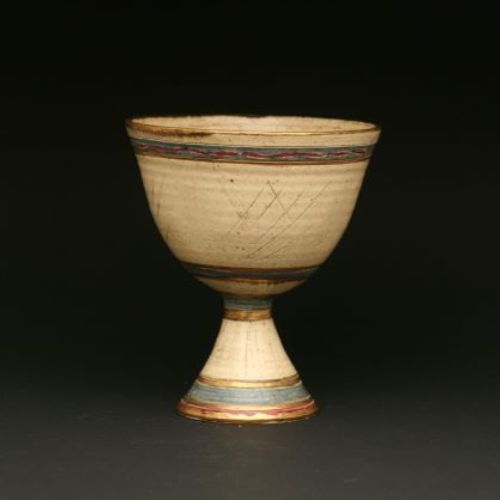
Bernard Forrester was born in 1908 in Stoke-on-Trent, later serving an eight-year apprenticeship there as a modeler at Mintons (Europe’s leading ceramic factory during the Victorian era, and independent business from 1793 to 1968). After working for a short time in Italy he came home to study painting at Newcastle where he met Sir Herbert Read, the eminent art historian, critic and poet, who urged him to join The Leach Pottery in St. Ives.
Forrester potted with Bernard Leach at the Leach Pottery between 1932 -34, but he soon became disenchanted with the repetitive work. He left to take over from David Leach at Dartington Pottery, Shinners Bridge and began teaching there full-time, with many children developing a passion for pottery under his tutelage.
Forrester developed his own unique style of pottery, vowing that no two pots would be the same after his time at the Leach Pottery. He created porcelain bowls, dishes and vases often decorated with geometric polychrome designs reminiscent of Persia and the Eastern Mediterranean using gilt glazes, as well as simpler slipware designs.
After he retired from teaching in 1968 he had many successful exhibitions in England, Europe and America. A retrospective exhibition of Bernie’s work was held at Dartington in 1988, to mark his 80th birthday and to celebrate his long association with Dartington. Forrester died in 1990.
John Maltby (1936 – 2020)
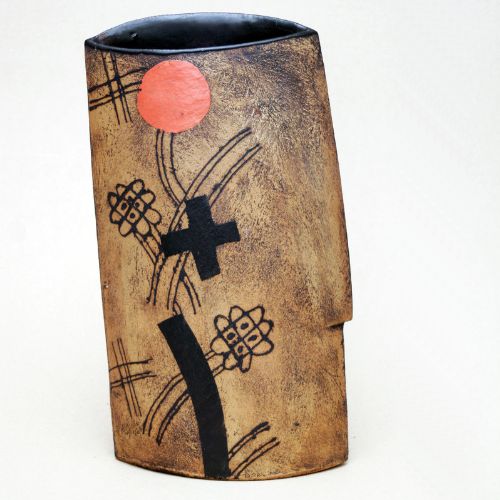
Maltby was born in Cleethorpes, Lincolnshire in 1936, later studying at Leicester College of Art specializing in sculpture and Goldsmith’s College in South London. He initially taught art at a small boys’ school in Caterham in Surrey. He visited Bernard Leach after reading his book, A Potter’s Book and on Leach’s advice he started working with David Leach in 1962 at Lowedown Pottery in Bovey Tracey, Devon as an apprentice. In 1964 he set up his own studio at Stonehill, near Crediton.
His style changed from his original Leach-inspired Anglo-Japanese style to more hand-formed figurative sculptures in the late 1990s after a stroke in 1996. His work has a distinctive, mostly style inspired by his love life long of the sea, as well as ancient cultures, English historical figures, myths and legends. His use of symbolism, especially symbolic animals and creatures can be interpreted as statements of his own view of the world in which we live now, but the interpretation is left entirely to the viewer.
He was a member of the Craft Potters Association, the British Craft Centre and an advisor for the Leach Archive. Exhibited worldwide, and is in many public and private collections – including the V&A.
John Pollex
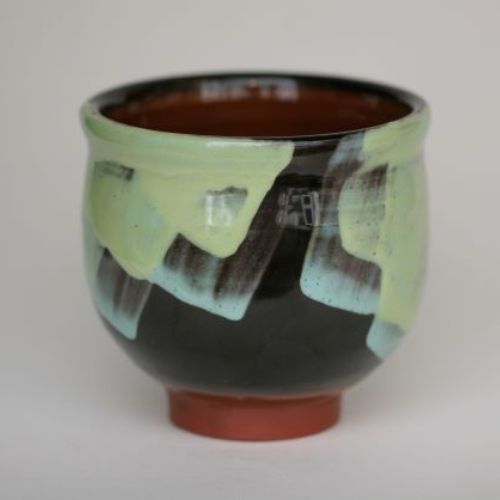
John Pollex studied at Sir John Cass in Whitechapel from 1966-1968, becoming a technician at Harrow College of Art between 1968-70, until he became an assistant to Colin Pearson. He moved to Plymouth in 1971 setting up his own workshop and during the 1970s and early 1980s, John Pollox established himself as a maker of traditional slipware. But in 1981 he was invited to take part in a lecture tour of New Zealand with contemporary ceramicist Ron Reitz, whose use of bold colours inspired him to change direction.
In 1984, inspired by and referencing artists like Sir Howard Hodgkin, Robert Natkin, Patrick Heron and Den Nicolson, and using his vast knowledge and understanding of slip application he developed a totally different style. Using paint brushes, sponges, and spatulas he created intensely coloured earthenware, which he applied in a free and abstract manner to his pots.
Zen Buddhism and music have also been great influences within his working practice. His brush strokes in evoke Zen calligraphy and he often plays music when he is painting his pieces; creating an atmosphere that reflects his moods and feelings.
Tim Andrews
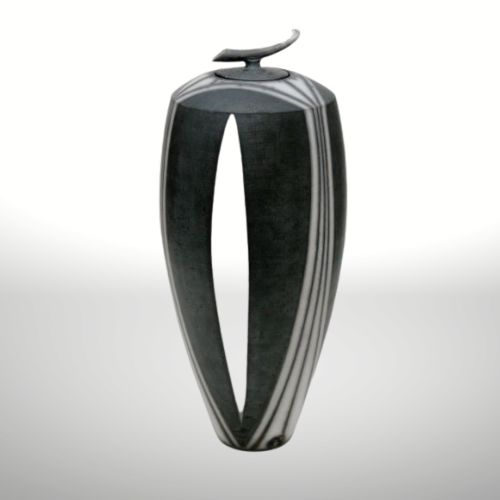
Andrews trained as a studio apprentice with David Leach from 1978 – 79, with two years at Dartington Pottery Training Workshop, being employed by them until 1982 making one-off pieces and teaching. Moving from Exeter to South Tawton Pottery, he set up and ran International Ceramics Summer Schools with students from all over the world until 1986 when he moved to Bovey Tracey to share a workshop with David Leach. He has been at his present studio at Woodbury, East Devon since 1993, also lecturing part-time at Exeter College and Plymouth College of Art and Design between 1994-95. He has lectured in Advanced Raku in Italy and in Denmark.
Andrews’ makes individual Raku work – black and white with linear decoration or burnished muted coloured slips. Usually thrown, some new work is also hand-built. His work is Bisque-fired in a conventional gas kiln to 1060C though many of his pieces have a ‘resist’ slip and glaze applied and are then fired in a ‘top hat’ fibreglass kiln to around 1000C, before transference when red-hot to a smoking chamber.
Tim Andrews’ work has been exhibited in many group and solo exhibitions throughout the UK and abroad, including in China, India, USA, Japan, The Netherlands, France, Italy, Germany, Denmark, Belgium and Sweden. His works are in many public and private collections including Stoke on Trent and Liverpool Museums, Ashmolean Museum, St John’s College – Oxford, Donna Karen – New York, Lord Chancellor Lord Irving, Imerys, The Royal Bank of Scotland (2006), Abromavich Collection, Coutts Bank and Fitzwilliam Museum and Cambridge.
Richard Batterham
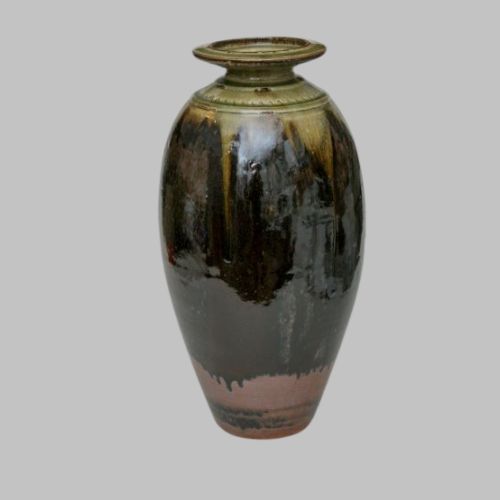
Born in 1936, Batterham became interested in pottery early on. He learnt under the guidance of Donald Potter, a student of Eric Gill. After National Service, Batterham worked for two years under Bernard Leach at the Leach Pottery in St. Ives, Cornwall. He left in 1959 to set up their own pottery at Durweston outside Blandford, moving to a new pottery and workshop in Durweston in 1967 where they Batterham and his wife built a four-chambered oil and wood-fired kiln and a small salt glaze kiln.
His pots are referred to as some of the finest domestic stoneware in the Leach and Cardew traditions. His colours are often soft blues and greens though to caramel, browns and blacks with the nature of his glazes varying from thin and bright to thicker softer glazes. His forms are simple and functional.
His work is in numerous museums, including the Tate and the V&A, as well as private collections. It has been shown all over the world.
‘Michael Cardew used to say form was everything, and form is very important, but I tend to feel that it’s how the clay is handled that really makes a difference. I like to make something you can hold. If someone really hugs onto a pot, that’s lovely and just how it should be.’ Richard Batterham.
Mary Rich (1941-2022)
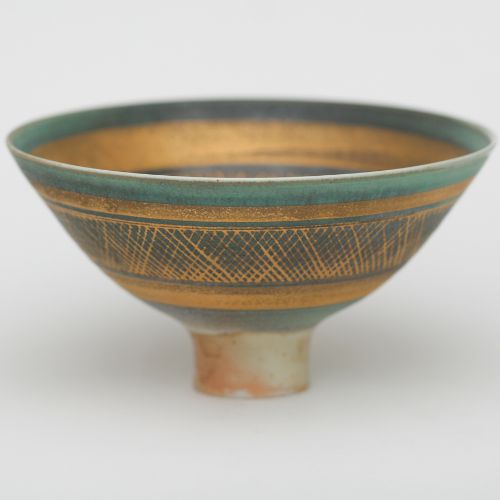
Mary has been working as a professional potter since 1962 and she remains one of Britain’s finest ceramicists. She is a Fellow of The Craft Potters Association and a member of The Devon Guild of Craftsmen.
Mary initially gained a National Diploma of Design from Bournemouth Municipal College of Art followed by working with Harry and May Davis at the Crowan Pottery. Further experience was gained by working with David Leach OBE at Lowerdown Pottery, Bovey Tracey, Devon. By 1962 Mary had started working on her own and in 1969 she established her current pottery at Cowlands Creek, Devon where she continues to live.
Her early works were high-fired domestic and decorative pieces. However, since 1983 she has only produced thrown porcelain and is best known for the way in which she has mastered a combination of underglaze stains and coloured slips which are fired with a clear matt stoneware glaze. After the porcelain has been in the stoneware firing geometric designs in gold lustre are fired on top of the glazed pots to a lower temperature). The gold lustre is banded and painted by hand.
Her work continues to be collected on a world-wide basis and is housed in many private and public collections.
Mary’s 80th Birthday Retrospective was due to take place at The Round House Gallery, Foston, Derbyshire in May 2020. It unfortunately has been cancelled until a future date (due to COVID 19) can be found. Over 150 pieces dating back to the early 1960s will eventually be for sale.
Clive Bowen
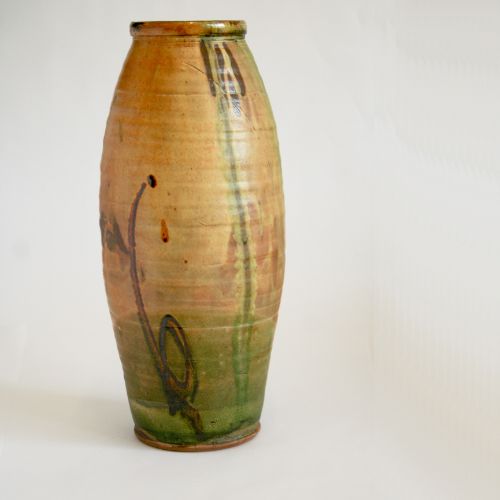
Clive Bowen was born in Cardiff in 1943. He studied painting and etching at Cardiff Art School in the early 1960s before taking up a pottery apprenticeship with Michael Leach at Yelland Pottery, followed by a further year at Brannam Pottery in Barnstaple. He has been making wood-fired earthenware at Shebbear Pottery since the early 1970s. He continued to make pieces from local Fremington clay. Described as a ‘gestural decorator’ he used slip spontaneously for trailing, pouring and combing decorations.
His work is currently in the RJ Lloyd Collection at the Burton Art Gallery and Museum, as well as at the V&A, Fitzwilliam Museum, York City Art Gallery. His work is also in collections around the world, including Canada, Japan and Germany. Large double-chambered wood firing kiln.
David Leach (1911-2005)
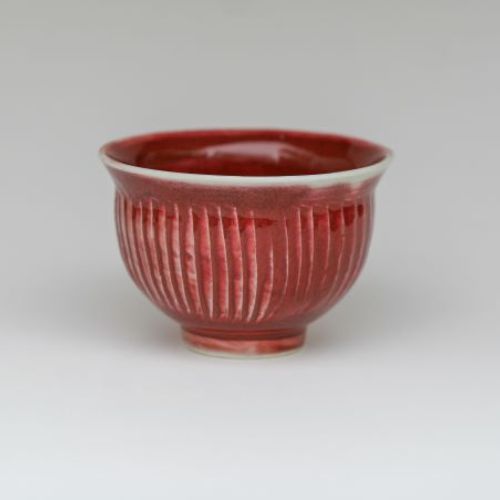
Leach was born in Tokyo, Japan in 1911. He was first taught to make pots by Shoji Hamada in Japan studying pottery management later at North Staffs Technical College. He joined the Leach Pottery, St. Ives, in 1930 where he stayed for twenty-five years. He helped the family business in an artistic, practical, technical and managerial capacities.
In 1953 he left the Leach Pottery to head the ceramics department at Loughborough College and started his Aylesford Pottery in 1954 which he handed over in 1955 to Colin Pearson. He moved to Bovey Tracey in Devon setting up the Lowerdown Pottery there. Here he became known for this porcelain.
He was chairman of the Craft Potters Association in 1967 exhibiting widely in the UK as well as America, Japan, Istanbul and Europe. In 1987 he was awarded an O.B.E for his services to to education and his work in studio pottery. David Leach died in February 2005.
Marianne De Trey (1913-2016)
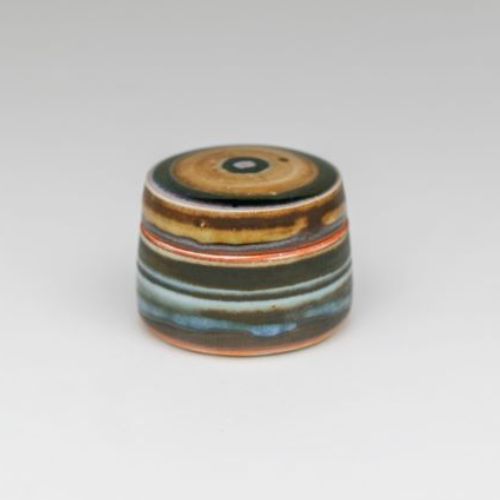
De Trey was born in London and, after boarding school, she studied textiles at the Royal College of Art in London graduating in 1936. In 1938 she married artist Thomas Samuel Haile and the couple travelled to the US in 1939 due to Haile’s anti-war beliefs, and there de Trey discovered a passion for pottery.
Shortly after returning to England De Trey and two of her sisters started producing pottery at Dartington, in Devon. By 1950 she was employing three people, and would later run her pottery company, Shinner’s Bridge Pottery for over 30 years. De Trey was a founder member of the Devon Guild of Craftsmen and Craft Potters Association.
Unfortunately, De Trey’s pottery studio burned down due to an electrical fault in 1957, leading her to change her focus from earthenware to stoneware. Her new designs incorporated a simple brown and white glaze and deft brushwork exploring lively bird and plant motifs. In the 1960s she developed more austere fluted forms with a Scandinavian quality, as well as ash- and iron-glazed pieces, more Anglo-oriental in style.
By 1976 she had established a training workshop adjacent to her pottery. She was a founding member of the Craft Potter’s Association and helped establish the Devon Guild and the Dartington Pottery Training Workshop. She retired from production work in 1980 and her focus changed again, this time to individual work. She was made a CBE for services to the arts in the 2006 New Year Honours.
De Trey made celadon and lustre-glazed porcelain and finally retired in her early 90s. She died in 2016, her work had a significant impact on the craft’s post-World War II revival.
Michael Casson (1926-2003)
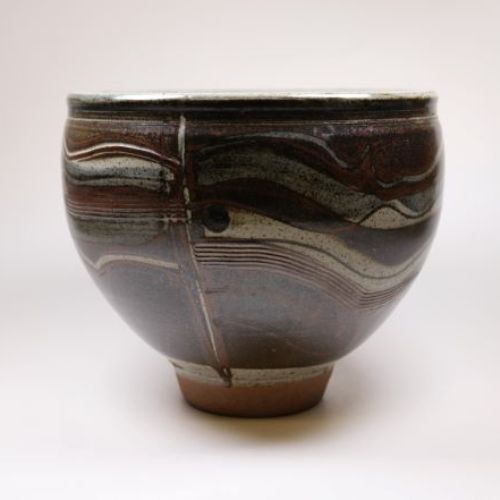
Casson made his first pots at an evening class in 1945, followed at studies at Shoreditch College, where he took a teacher’s course, specialising in art and woodwork. From 1948, at Hornsey School of Arts and Crafts, he gained an art teacher’s diploma. Casson always maintained that he was self-taught as he could not find tutors.
Casson was influenced by the culture of ancient Greece, and he was influenced more by Minoan and Mediterranean pottery. In 1952, he established a pottery in the basement of his uncle’s hardware shop in Marchmont Street, Bloomsbury. Using red clay, black slip and a richly reactive lead-based tin glaze, he produced useful and decorative wares, including a memorable series of lidded jars with modelled knobs in the form of abstracted birds. In 1959, the pottery moved to Prestwood, Buckinghamshire, changing from earthenware to reduced stoneware.
He was a founder member of the Craftsman Potters Association (CPA), he was appointed director of the newly formed Crafts Advisory Committee (later the Crafts Council),
Teaching at Harrow, Casson transformed many young potters into professionals, progressing to working in 1976 with the BBC on his TV series The Craft Of The Potter.
By the late 1970s, the family had moved to Wobage Farm, Herefordshire, where it was possible to fire kilns with wood and to salt-glaze. They ran a summer school was run, and the community of makers at Wobage expanded, first with family, then with talented art school graduates.
Blandine Anderson
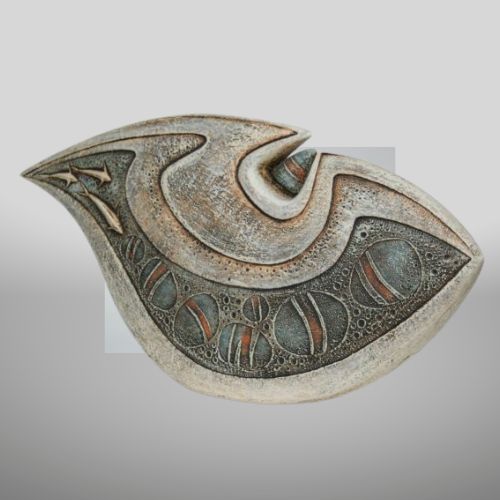
After studying Fine Art Ceramics (BA Hons) at Exeter College of Art and Design, Anderson taught for five years at colleges in Somerset before setting up her first ceramic studio in Devon in 1988. She has since established a reputation as an artist intent on pushing creative boundaries and has gained an enthusiastic following for her hugely collectable one-off sculptural works.
“Although my work is dominated by the broad theme of animals in landscape – the driving forces behind it are really composition and proportion. Since I come from a Fine Art background, I lean towards a sculptural approach. As a result, I am torn between wanting to make simple sculptural forms and more decorative works which are whimsical, meaningful and communicate my love of the subject.”
Within her work base forms are often conceived before the overall design is finalised. The base is then “populated” with creatures chosen to enhance it: hares and foxes for long fluid lines; sheep to punctuate; birds to break through the form. As a small-holder and nature-enthusiast environmental issues are never far from her thoughts and are constantly referred to in the work.
Anderson has exhibited in both solo and group exhibitions throughout the UK.
Jason Wason
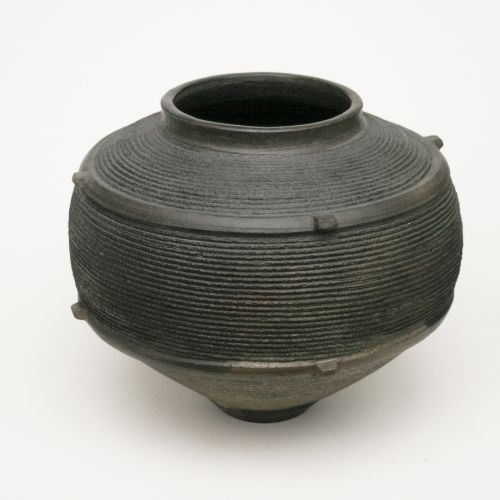
Wason was born in 1946. A self-taught artist from a young age he travelled the world and experienced a multitude of cultures – the Balkans, the middle East and Asia. It was his skill as a craftsman which supported these travels, and he learnt various local practices whilst also exporting local culture.
In 1972 Wason settled in Scotland where he set up a co-operative with a weaver, a saddler and a jeweller. It was here that he started potting. Four years later, he moved to Cornwall and started work at Bernard Leach’s St Ives Pottery as an assistant in the production of domestic pottery and became accomplished at the traditional ‘thrown on the wheel’ technique.
Wason made functional pieces but by the late 1980 he was making increasingly bigger, more ambitious vessels. He is inspired by the great ceremonial wares of the past, and by his deep affinity with nature – broad deep bowls, jars, pouring vessels, disk-like containers, lidded jars and big dishes – and fused ancient elements of form with the many types of craft he had seen on his travels whilst also retaining the direct, ever-present light, colour and texture of his Cornish home.


